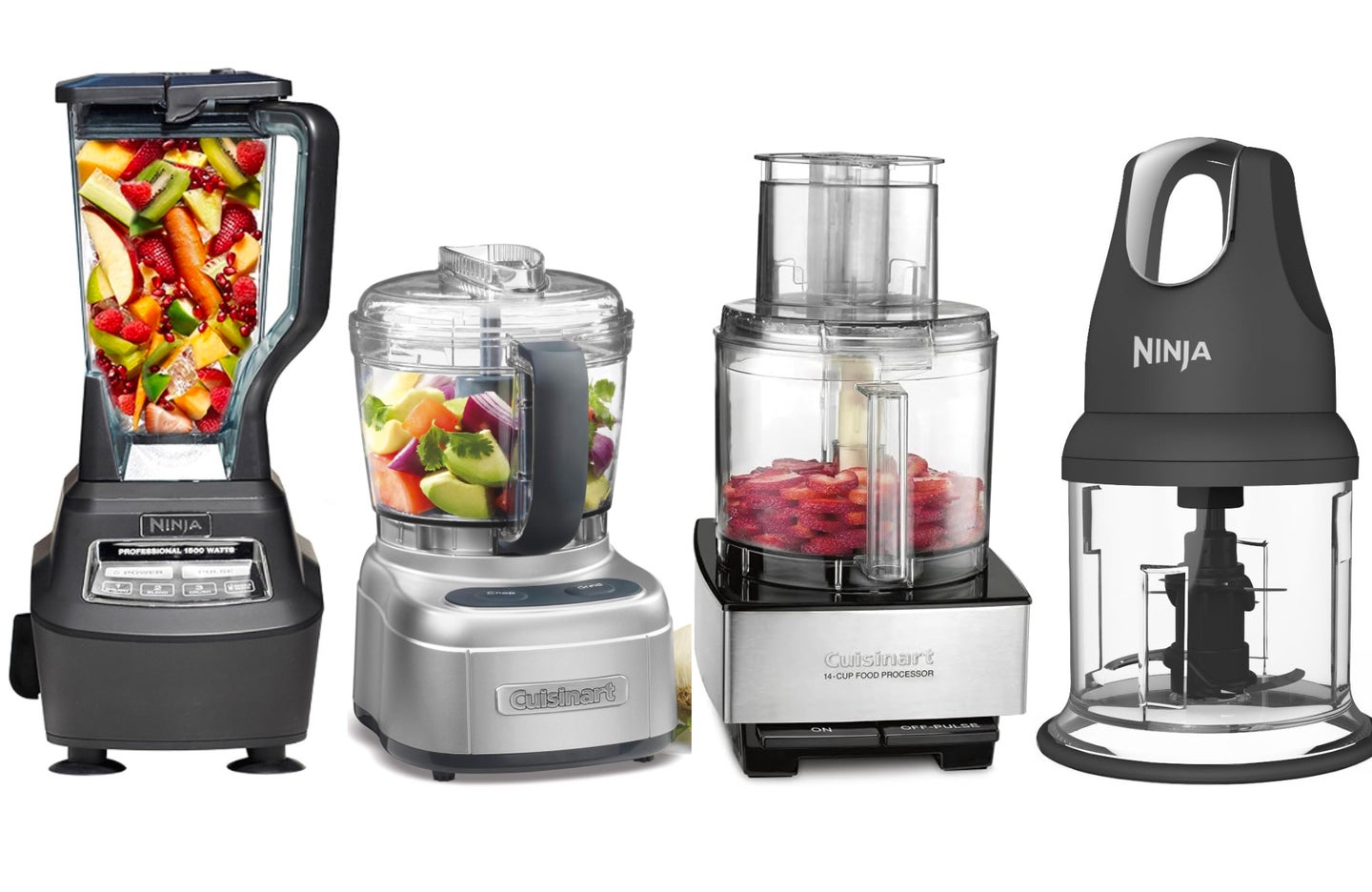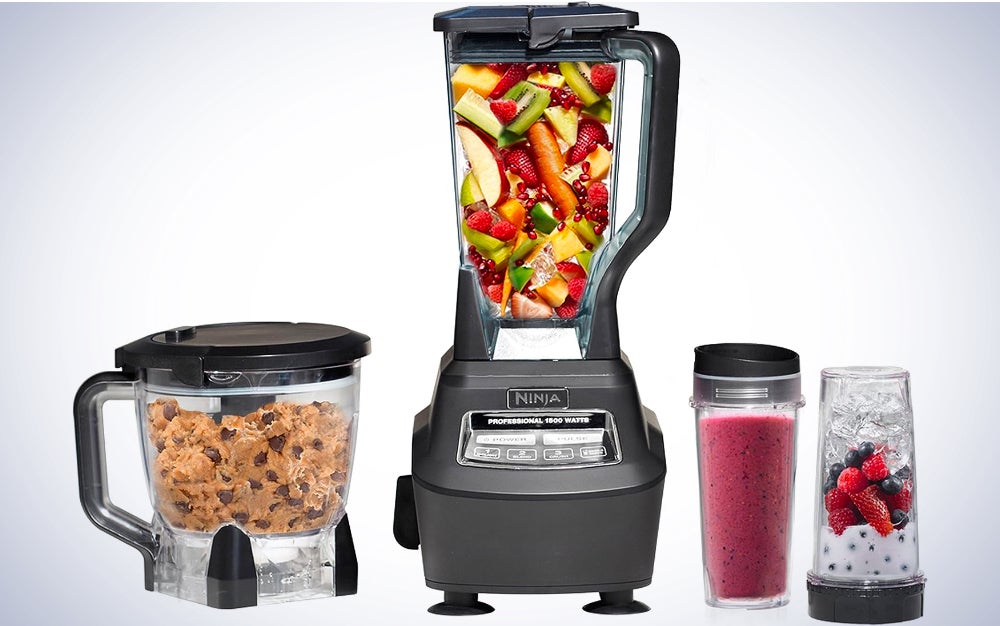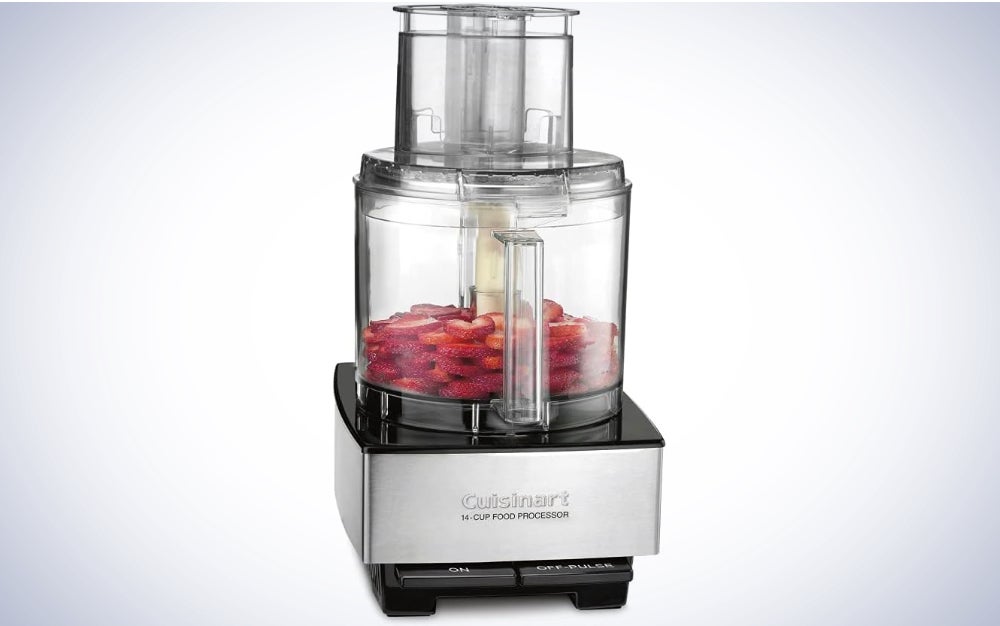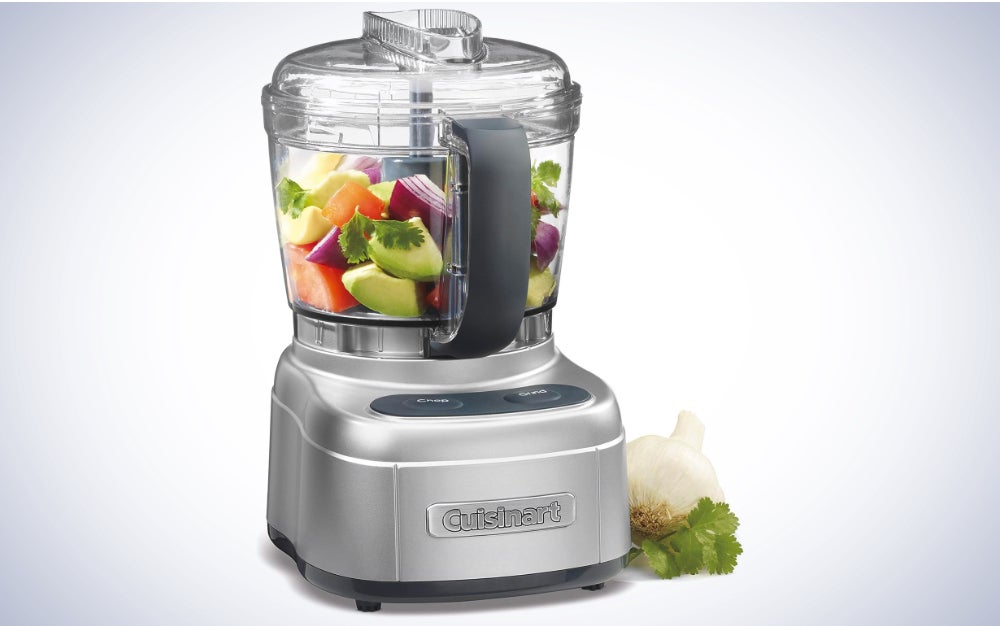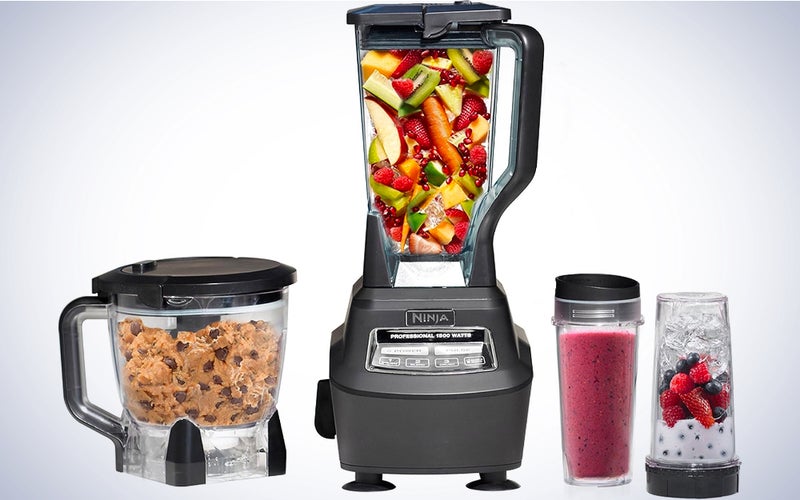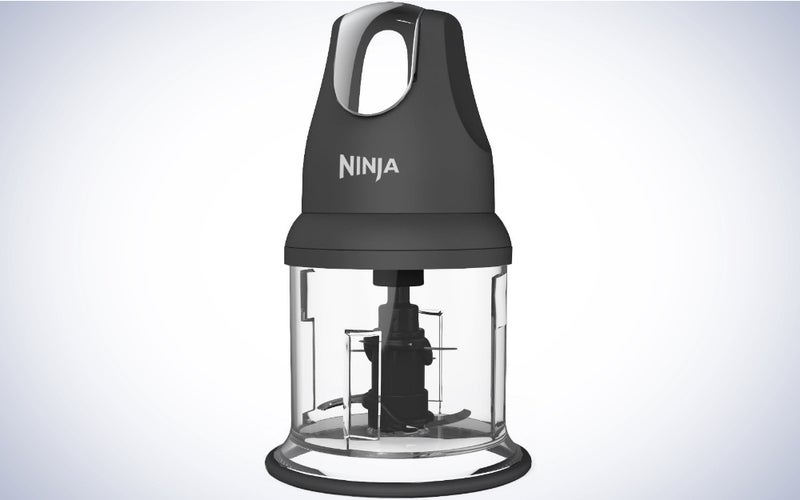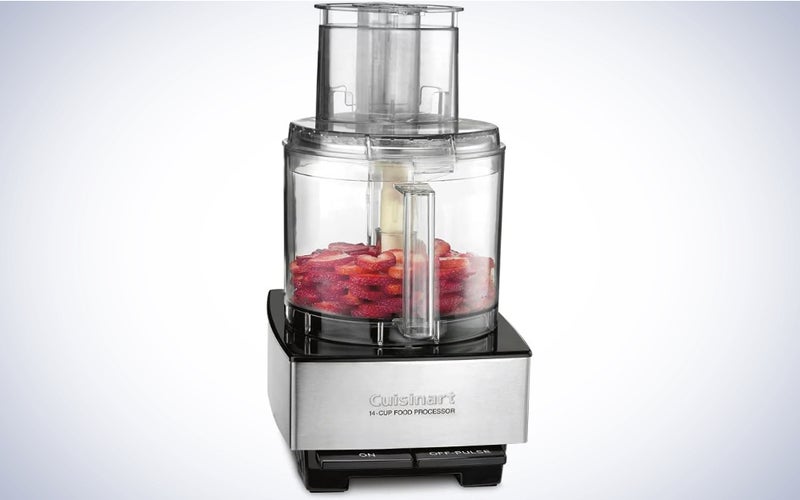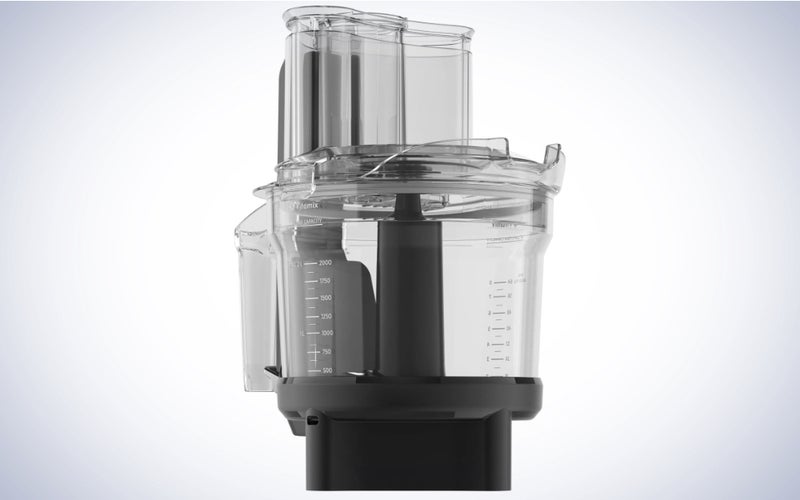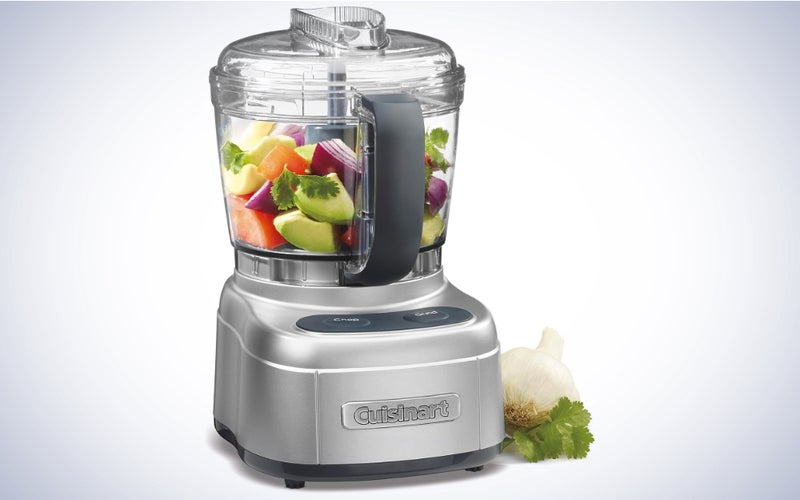We may earn revenue from the products available on this page and participate in affiliate programs. Learn more ›
A food processor is a countertop appliance that opens up new culinary possibilities. They blend, mix, and chop anything from onions (without the tears) to chickpeas for homemade hummus. Unlike a blender, which provides a uniform result every time, you can get plenty of variety in the size and texture of your dish using a food processor. However, there are plenty of machines on the market that over-promise and under-deliver on power and durability. So, to help ensure that you find the best food processor for your kitchen, we’ve narrowed down the list of the top five food processors on the market.
- Best overall: Ninja BL770 Mega Kitchen System
- Best mini: Ninja Express Chop Professional
- Best large capacity: Cuisinart DFP-14BCNY 14-Cup Food Processor
- Best food processor blender attachment: Vitamix 12-Cup Food Processor Attachment
- Best budget: Cuisinart ECH-4SV Elemental 4-C Chopper
How we chose the best food processors
To select the best food processors in every category, I took into account personal testing experience with the products, as well as customer reviews and product specifications. In particular, I looked for the top-performing appliances in a range of sizes and price points to accommodate every home cook. I also sought products with appropriate power for their size to ensure efficiency. In addition, I looked for helpful features like dishwasher-safe parts, useful cutting accessories, and smart design features, such as pulsing or multiple power levels. I have personally tested the Cuisinart and Ninja products on this list and regularly use both my Cuisinart 14-cup food processor and smaller Ninja food chopper.
The best food processors: Reviews & Recommendations
When trying to find the best food processor for your kitchen, you must first consider what you want the machine to do. You clearly wouldn’t use a KitchenAid mixer to make a smoothie, but it’s also not as simple as picking up a Vitamix. The majority of tasks will be easily achieved with a few basic blades. Extras and accessories are neat but pointless if you don’t use them. Higher-quality stainless steel blades in combination with a powerful motor will help deliver the most precise slices, be able to handle tough jobs, as well as offer you the longest life span. Simple designs and dishwasher-safe parts are also important features to consider before deciding on which machine to purchase for all of your meal prep.
Best overall: Ninja BL770 Mega Kitchen System
Ninja
Specs
- Capacity: 64 ounces (food processor); 72 ounces (blender)
- Product dimensions: 9.5 inches L x 8.25 inches W x 17.75 inches H
- Wattage: 1500 W
Pros
- Includes single-serving blending cups
- Dough mixer blade
- Comes with recipe booklet
Cons
A lot of pieces to store
If you’re looking for both a food processor and a blender, this kitchen system from Ninja has it all. It comes with a 72-ounce blender pitcher and 64-ounce food processor bowl that both fit onto the powerful motor base for blending, chopping, crushing, or pureeing just about anything. The system also includes two single-serving blender cups that double as smoothie takeaway cups. In addition to a four-blade food processor attachment, you’ll also get a dull dough mixer attachment, which can knead up to two pounds of dough in seconds to save your hands from the tiring work.
All of the non-electrical parts are BPA-free and dishwasher safe, though the company recommends hand-washing the blades to maintain their sharp edge as long as possible. If you’re wondering what to make with your new system, there’s even a 31-recipe booklet full of inspiration for drinks, dips, doughs, and more.
Best mini: Ninja Express Chop Professional
Ninja
Specs
- Capacity: 16 ounces
- Product dimensions: 5.75 inches L x 5.75 inches W x 10.13 inches H
- Wattage: 200 watts
Pros
- Easy to use
- Dishwasher safe
- Great for travel
Cons
- No slicing or grating attachments
- One power setting
Whether you’re camping, traveling, or just want a food processor that performs well but won’t take up your entire pantry, this option from Ninja is the way to go. It’s incredibly lightweight (just two pounds), convenient to store, and still can mince, chop, or puree like the best of them. In fact, though this processor has just one power setting, it’s strong enough to grind harder ingredients like roasted nuts and can make a smooth and fluffy sauce in minutes. Because the blending bowl is smaller, you don’t have to stop and scrape it down as often as larger products.
The bowl also comes with an airtight storage lid so you can blend up salsa and stash it in the fridge right in the blender bowl for later. While you shouldn’t expect to use this miniature processor for the same volume as a larger and more powerful model, it does execute small jobs, such as chopping soft vegetables, perfectly. For cleaning, the bowl and blade are dishwasher-safe.
Best large capacity: Cuisinart DFP-14BCNY 14-Cup Food Processor
Cuisinart
Specs
- Capacity: 14 cups
- Product dimensions: 11 inches L x 7.9 inches W x 14.8 inches H
- Wattage: 720 watts
Pros
- Powerful
- Pulse feature
- Includes shredding and slicing blades
Cons
- Expensive
- Large to store
This large-capacity food processor is a total workhorse. It’s the ideal appliance for large households or any cook who plans to use their food processor regularly. The heavy-duty plastic blending bowl has a spacious 14-cup capacity, which can whip up homemade hummus for a crowd of 10 in minutes. The large blender is powered by a whopping 720 watts of power.
The machine is also well-designed with a 36-inch long cord, which is great for kitchens that may be low on electrical outlets. The processor comes with a stainless steel slicing disc, a medium shredding disc, and the standard stainless steel S blade for pureeing and chopping. It also comes with a food-scraping spatula and a recipe booklet for meal inspiration. The bowl, lid, and blades are all dishwasher safe, and it even comes with a full five-year warranty, so you can rest assured that this investment will last.
Best blender attachment: Vitamix 12-Cup Food Processor Attachment
Vitamix
Specs
- Capacity: 12 cups dry, 9 cups wet
- Product dimensions: 11.75 inches L x 8.5 inches W x 12.75 inches H
- Voltage: 240 volts
Pros
- Saves space
- Includes slice/shred discs
- Dishwasher safe
Cons
- Requires Vitamix base (sold separately)
Expensive
Vitamix is known for making some of the most powerful blenders on the market, so it’s no surprise that the brand knows what it’s doing when it comes to food processors. This food processor bowl is compatible with Vitamix Ascent and Venturist blender bases, so if you already have a Vitamix base or are considering a new blender, this is a great way to save space at home (though it’s not cheap). For the price, however, you get an extremely durable appliance that does its job faster than most.
The food processor comes with two food pushers in two different sizes, a standard S blade, two reversible slicing and shredding discs for safe and uniform cutting, and even a carrying case to protect the blades. Unlike some processors, which can be difficult to attach to their base, the Vitamix model has a helpful Self-Detect system that simply shuts off if the bowl is not properly in place. The parts are also dishwasher safe and made from BPA-free clear plastic.
Best budget: Cuisinart ECH-4SV Elemental 4-C Chopper
Cuisinart
Specs
- Capacity: 4 cups
- Product dimensions: 5.88 inches L x 8.13 inches W x 10.25 inches H
- Wattage: 250 watts
Pros
- Includes spatula for food removal
- Comes with recipe book
- Dishwasher safe
Cons
- Only two settings (grind and chop)
- No slicing or grating accessories
Though this budget-friendly food processor won’t win any awards for flashy features, it’s a reliable and high-performing option that’s a great size for smaller households of four or fewer people. The machine weighs just over three pounds, making it easy to store even in hard-to-access places, such as over your fridge. The clear blender container is made from durable BPA-free plastic, and the container and S blade are dishwasher-safe. Two buttons on the front make it easy to chop (the lower setting) or grind (a higher speed) anything from fresh salsa to homemade nut butter. The Cuisinart bladelock system ensures that nothing will come apart once you start processing, as the machine will not turn on until everything, including the lid, is tightly locked in the correct position.
What to consider when looking for the best food processors
When trying to find the best food processor for your kitchen, you must first consider what you want the machine to do. The majority of tasks will be easily achieved with a few basic blades. Extras and accessories are neat but pointless if you don’t use them. Higher quality stainless steel blades in combination with a powerful motor will help deliver the most precise slices, be able to handle tough jobs, as well as offer you the longest life span. Simple designs and dishwasher-safe parts are also important features to consider before deciding on which machine to purchase.
How powerful should your food processor be?
The best food processors will be able to handle all types of jobs, from delicate slicing to chopping hard vegetables and mixing dough. Power wattage refers to the amount of electricity the machine uses. For example, a 1000-watt machine uses 1 kilowatt for one hour of use. The higher the wattage, the more power and strength the machine has to tackle jobs without stalling. It’s important to note that if your machine’s power becomes overloaded, you should turn it off and let the motor cool down before reusing. The major benefit of a higher-wattage food processor is the machine’s ability to discriminate and control the quality of the cutting. In addition, this higher power can capably handle sticky and tough ingredients.
The majority of devices have a pulse feature that allows for short bursts of power at optimum speed. This gives the user added control over the amount of processing the machine will do. This is a useful feature to prevent over-processing your food items.
Look for dishwasher-safe parts
The most effective food processors are designed to save you time and effort. However, the added time assembling and then cleaning after use can impact the overall convenience and practicality of these items. With this in mind, it is smart to look for a food processor with detachable, dishwasher-safe parts, as this will save a great deal of time and make the experience more satisfying.
When considering what materials hold up best in the dishwasher, you want to avoid materials that will tarnish, rust, shatter, or melt. High-quality stainless steel is the best choice for a dishwasher-safe material. Plastic parts can be added to the dishwasher if they are deemed dishwasher-safe by the manufacturer, but it’s best to place them on the top rack, which is further from the heating elements on the dishwasher. Also, it is best to avoid high heat settings if your dishwasher has those options (like a sanitizing mode) to prevent any melting or distortion of plastics.
Juicer combos
Who doesn’t like fresh orange juice? Or a fresh citrus marinade? Food processors and juicers are both really convenient machines to have in your kitchen and allow for many ways to create fresh and healthy foods and drinks. But truth be told, the more of these machines you have, the less storage space available for anything else. Both food processors and juicers require a powerful motor and the ability to chop—so it’s not a bad idea to consider a space-saving device that combines multiple functions.
While a solitary juicer may offer more functions specific to the art of juicing, if you are interested in mainly citrus juicing, it’s worth considering a food processor that has an attachment to handle that. It is possible to do other types of juicing, but straining would be required by the user. If your kitchen would benefit from traditional chopping and fresh citrus juices, it’s a safe bet to combine these devices in a juice combination food processor.
How much cupboard space do you have?
Not every job in the kitchen requires a large volume cup and a big heavy machine. Often, a smaller food processor is the best and fastest solution and one that you will get the most use out of. Even if you are blessed with an abundance of cabinet space, the sheer act of unboxing and setting up a very large machine (never mind also cleaning it and putting it all away) can be a deterrent for small daily food prep jobs.
Most small-batch daily cooking requires small portions. Whether mincing onions and garlic, making sauces and dressings, or dicing up nuts, you are often working with small portions. Smaller portion food processors are also typically more budget-friendly, so it is useful to consider this type of food processor if you anticipate you will most likely be using the machine for these small daily jobs.
Should your device perform more than one function?
If space is a concern and convenience a must, then it makes sense to invest in a food processor that can fill multiple roles in your kitchen prep. Beyond just processing food or making juice, some devices can surprise with additional functionality that quickly takes them from helpful to necessary. So many people miss out on culinary adventures simply because the prep seems so daunting—but a processor that makes any step along the way easier will open doors.
It’s not easy to find a device that does many things, much less many things well, but those that do typically prioritize user-friendliness and convenient cleanup. These are important considerations, as a lack of either will make just the thought of reaching for your processor a chore, defeating the purpose.
FAQs
Q: How do I determine how much power I need for my food processor?
Typically, food processors range in power from 500W to 1000W. A rule of thumb is 700W and above should handle most jobs. Smaller, easier jobs consisting of softer foods do perfectly well at the low end of the power wattage spectrum. On the higher end (wattage closer to and above 1000W), you get more professional quality. With a higher-power motor, the processor should be able to handle even the most difficult kitchen prep, including tough fruits and veggies, frozen items, and dough.
Q: What size food processor should I buy?
Typically, they range in power from 500W to 1000W. A rule of thumb is 700W and above should handle most jobs. Smaller, easier jobs consisting of softer foods do perfectly well at the low end of the power wattage spectrum. You get more professional quality on the higher end (wattage closer to and above 1000W). With a higher-power motor, the processor should be able to handle even the most difficult kitchen prep, including tough fruits and veggies, frozen items, and dough.
Q: What type of blades and attachments do I need?
The best food processors can handle a wide variety of kitchen prep jobs. Across the board, any food processor will offer an S-shaped blade for chopping and a disk for grating and slicing. Higher-end models will offer better-quality blades that will remain sharp for years of use. In terms of extras, some food processors come with a dough blade, juicing attachment, and specialized julienne disks.
Q: How can I find a food processor that is easy to use?
Ease of use will make you more likely to enjoy your food processor and more likely that you will actually use it frequently. Fewer controls to navigate make a unit easier to use—so if convenience is key, you really don’t need much more than an on-and-off switch and pulse function. Dishwasher-safe parts will also be easier as it will make your clean-up quicker.
Final thoughts on the best food processors
- Best overall food processor-blender system: Ninja BL770 Mega Kitchen System
- Best mini: Ninja Express Chop Professional
- Best large capacity: Cuisinart DFP-14BCNY 14-Cup Food Processor
- Best food processor blender attachment: Vitamix 12-Cup Food Processor Attachment
- Best budget: Cuisinart ECH-4SV Elemental 4-C Chopper
Your cooking preparation will be faster and more professional with the right food processing machine. The best food processors can offer you a plethora of chopping and slicing options, along with extra time to enjoy your meal. Whether you want professional-level power and the ability to cook for a crowd or a small time-saving machine for your countertop, there are many quality options to consider. You just need to decide which one will fit your lifestyle and fit into your kitchen.
Why trust us
Popular Science started writing about technology more than 150 years ago. There was no such thing as “gadget writing” when we published our first issue in 1872, but if there was, our mission to demystify the world of innovation for everyday readers means we would have been all over it. Here in the present, PopSci is fully committed to helping readers navigate the increasingly intimidating array of devices on the market right now.
Our writers and editors have combined decades of experience covering and reviewing consumer electronics. We each have our own obsessive specialties—from high-end audio to video games to cameras and beyond—but when we’re reviewing devices outside of our immediate wheelhouses, we do our best to seek out trustworthy voices and opinions to help guide people to the very best recommendations. We know we don’t know everything, but we’re excited to live through the analysis paralysis that internet shopping can spur so readers don’t have to.
